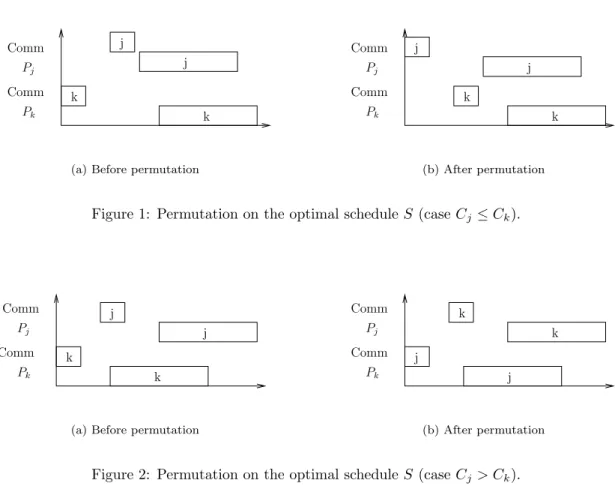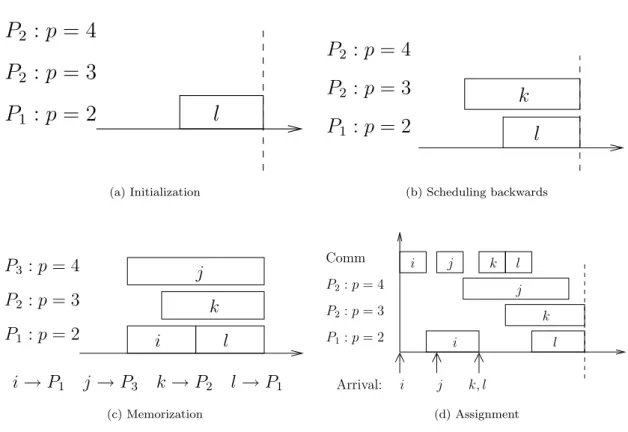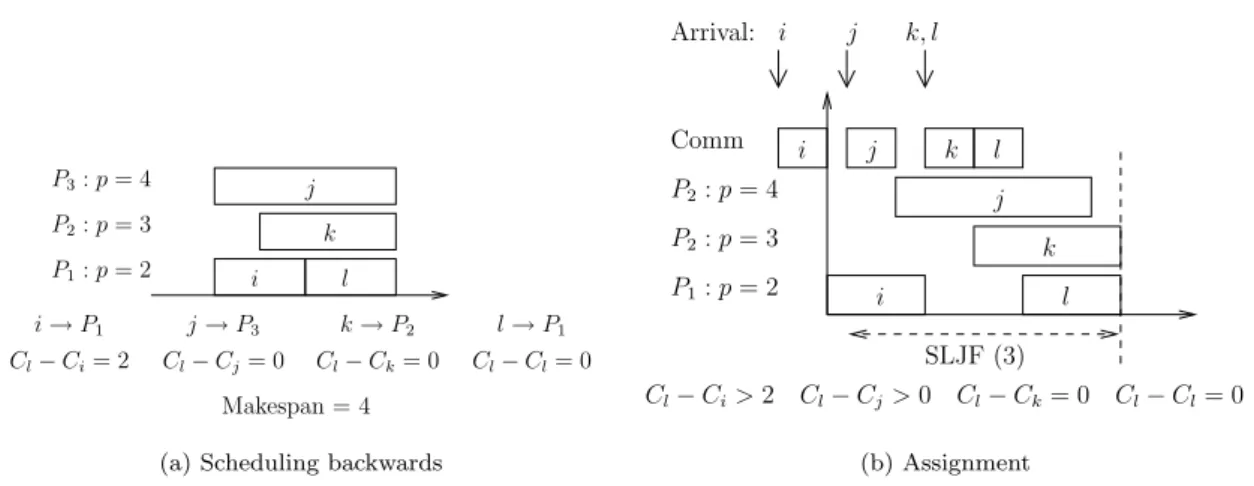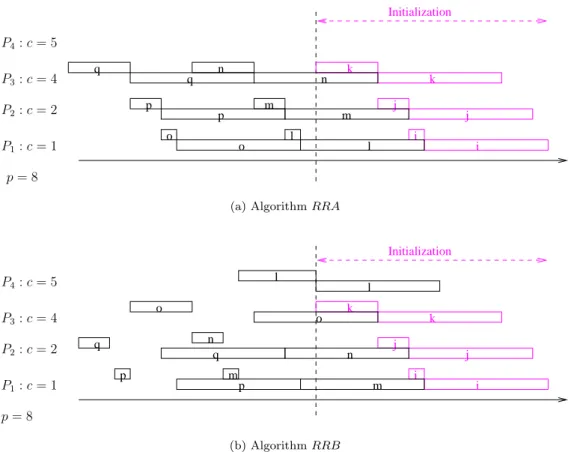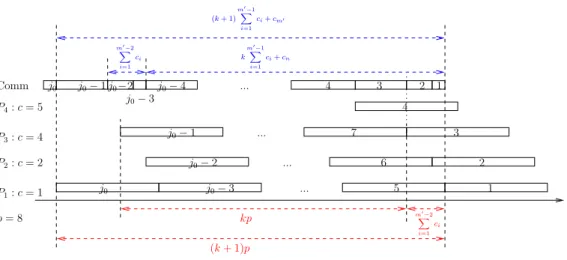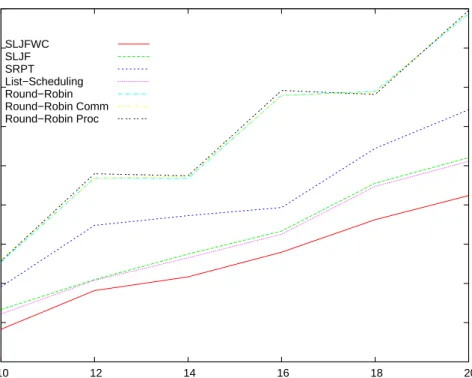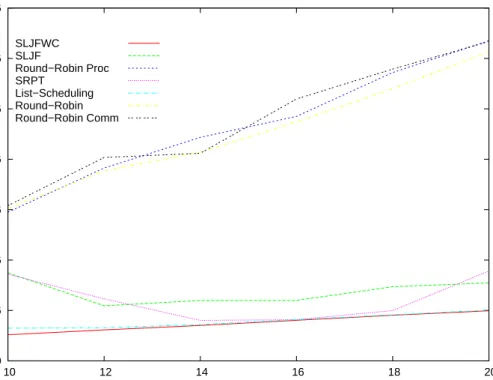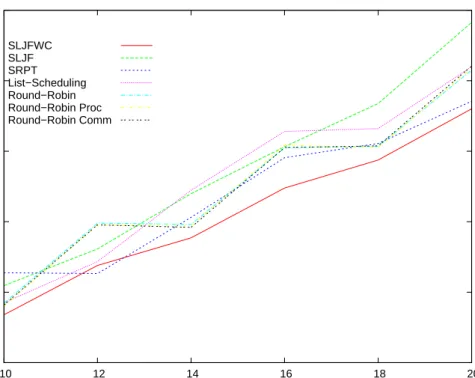Unité Mixte de Recherche CNRS-INRIA-ENS LYON-UCBL no5668
Off-line and on-line scheduling
on heterogeneous master-slave platforms
Jean-Fran¸cois Pineau,
Yves Robert,
Fr´ed´eric Vivien
July 2005
Research Report No2005-31
École Normale Supérieure de Lyon
46 Allée d’Italie, 69364 Lyon Cedex 07, France Téléphone : +33(0)4.72.72.80.37 Télécopieur : +33(0)4.72.72.80.80 Adresse électronique :lip@ens-lyon.fr
on heterogeneous master-slave platforms
Jean-Fran¸cois Pineau, Yves Robert, Fr´ed´eric Vivien
July 2005
Abstract
In this work, we deal with the problem of scheduling independent tasks on het-erogeneous master-slave platforms. We target both off-line and on-line prob-lems, with several objective functions (makespan, maximum response time, total completion time). On the theoretical side, our results are two-fold: (i) For off-line scheduling, we prove several optimality results for problems with release dates; (ii) For on-line scheduling, we establish lower bounds on the com-petitive ratio of any deterministic algorithm. On the practical side, we have implemented several heuristics, some classical and some new ones derived in this paper. We studied experimentally these heuristics on a small but fully het-erogeneous MPI platform. Our results show the superiority of those heuristics which fully take into account the relative capacity of the communication links.
Keywords: Scheduling, Master-slave platforms, Heterogeneous computing, On-line, Release dates.
R´esum´e
Nous nous int´eressons ici au probl`eme de l’ordonnancement d’un ensemble de tˆaches ind´ependantes sur une plate-forme maˆıtre esclave h´et´erog`ene. Nous con-sid´erons les probl`emes en-ligne (ou `a la vol´ee) et hors-ligne, pour des fonctions objectives diff´erentes (dur´ee totale d’ex´ecution, temps de r´eponse maximum, temps de r´eponse moyen). D’un point de vue th´eorique, nous obtenons deux types de r´esultats : (i) pour le probl`eme hors-ligne, nous avons ´etabli plusieurs r´esultats d’optimalit´e pour des probl`emes avec dates d’arriv´ee ; (ii) pour le probl`eme en-ligne, nous avons ´etabli des bornes inf´erieures sur le facteur de comp´etitivit´e des algorithmes d´eterministes. D’un point de vue pratique, nous avons impl´ement´e plusieurs heuristiques, certaines classiques, d’autres issues du pr´esent travail. Nous avons ´etudi´e exp´erimentalement ces heuristiques sur une petite plate-forme MPI totalement h´et´erog`ene. Les r´esultats exp´erimen-taux montrent la sup´eriorit´e des heuristiques qui prennent compl`etement en compte les capacit´es relatives des diff´erents liens de communication.
Mots-cl´es: Ordonnancement en ligne, Ordonnancement hors-ligne, Calcul h´et´erog`ene, Plate-forme maˆıtre-esclave
1
Introduction
In this paper, we deal with the problem of scheduling independent tasks on a heterogeneous master-slave platform. We assume that this platform is operated under theone-port model, where the master can communicate with a single slave at any time-step. This model is much more realistic than the standard model from the literature, where the number of simultaneous messages involving a processor is not bounded. However, very few complexity results are known for this model (see Section7for a short survey). The major objective of this paper is to assess the difficulty of off-line and on-line scheduling problems under the one-port model.
We deal with problems where all tasks have the same size. Otherwise, even the simple problem of scheduling with two identical slaves, without paying any cost for the communications from the master, is NP-hard [12]. Assume that the platform is composed of a master and m slaves
P1, P2, . . . , Pm. Let cj be the time needed by the master to send a task toPj, and letpj be the time needed byPj to execute a task. Our main results are the following:
• When the platform is fully homogeneous (cj =c and pj =pfor all j), we design an algo-rithm which is optimal for the on-line problem and for three different objective functions (makespan, maximum response time, total completion time).
• When the communications are homogeneous (cj = c for all j, but different values of pj), we design an optimal makespan minimization algorithm for the off-line problem with release dates. This algorithm generalizes, and provides a new proof of, a result of Simons [27]. • When the computations are homogeneous (pj = p for allj, but different value of cj), we
failed to derive an optimal makespan minimization algorithm for the off-line problem with release dates, but we provide an efficient heuristic for this problem.
• For these last two scenarios (homogeneous communications and homogeneous computations), we show that there does not exist any optimal on-line algorithm. This holds true for the pre-vious three objective functions (makespan, maximum response time, total completion time). We even establish lower bounds on the competitive ratio of any deterministic algorithm. The main contributions of this paper are mostly theoretical. However, on the practical side, we have implemented several heuristics, some classical and some new ones derived in this paper, on a small but fully heterogeneous MPI platform. Our (preliminary) results show the superiority of those heuristics which fully take into account the relative capacity of the communication links. The rest of the paper is organized as follows. In Section 2, we state some notations for the scheduling problems under consideration. Section3 deals with fully homogeneous platforms. We study communication-homogeneous platforms in Section 4, and computation-homogeneous platforms in Section5. We provide an experimental comparison of several scheduling heuristics in Section6. Section7is devoted to an overview of related work. Finally, we state some concluding remarks in Section8.
2
Framework
To be consistent with the literature [16,9], we use the notationα|β |γ where:
α: the platform– As in the standard, we useP for platforms with identical processors, and Q
for platforms with different-speed processors 1. We addMS to this field to indicate that we
work with master-slave platforms.
β: the constraints– We writeon-line for on-line problems, andrj when there are release dates. We write cj =c for communication-homogeneous platforms, and pj =p for computation-homogeneous platforms.
1As we only target sets of same-size tasks, we always fall under theuniform processors framework. In other
γ: the objective– We let Ci denote the end of the execution of task i. We deal with three objective functions:
• the makespan (total execution time) maxCi;
• the maximum response time (or maximum flow) max Ci−ri: indeed, Ci−ri is the time spent by taskiin the system;
• the total completion time P
Ci, which is equivalent to the sum of the response times P
(Ci−ri).
3
Fully homogeneous platforms
For fully homogeneous platforms, we are able to prove the optimality of theRound-Robinalgorithm which processes the tasks in the order of their arrival, and which assigns them in a cyclic fashion to processors:
Theorem 1. The Round-Robin algorithm is optimal for the problem P,MS | online, rj, pj =
p, cj = c | P(Ci−ri), as well as for the minimization of the makespan and of the maximum response time.
We point out that the complexity of the Round-Robin algorithm is linear in the number of tasks and does not depend upon the platform size.
Proof. To prove that the greedy algorithmRound-Robinis optimal for our problem, we show that there is an optimal schedule under which the execution of each task starts at the exact same date than under Round-Robin. To prove this, we first show two results stating that we can focus on certain particular optimal schedules.
1. There is an optimal schedule such that the master sends the tasks to the slaves in the order of their arrival.
We prove this result with permutation arguments. LetSbe an optimal schedule not verifying the desired property. Remember that the master use its communication links in a sequential fashion. Then we denote byr0
i the date at which the taskiarrives on a slave. By hypothesis onS, there are two tasks,j andk, such thatj arrives on the master beforek, but is sent to a processor slave afterk. So:
rj< rk andr0k< r0j. We then define fromS a new scheduleS0 as follows:
• If the taskj was nevertheless treated earlier than the taskk(i.e., if Cj≤Ck), then we simply reverse the dispatch dates of tasks j andk, but do not change the processors where they are computed. This is illustrated on Figure1. In this case, the remainder of the schedule is let unaffected, and the total flow remains the same (just as the makespan, and the maximum flow).
• If the task j was processed later than the task k, i.e., ifCj > Ck, then we send the task j to the processor that was receiving k under S, at the time task k was sent to that processor, and conversely. This is illustrated on Figure 2. Since the tasksj andk
have the same size, the use of the processors will be the same, and the remainder of the schedule will remain unchanged. One obtains a new scheduleS0, having as total flow:
n X i=1 i6=j,i6=k (Ci−ri) + (Ck−rj) + (Cj−rk) = n X i=1 (Ci−ri) (1)
Therefore, this is also an optimal schedule. In the same way, the makespan as well as the maximum flow are unchanged.
Pj Pk Comm Comm k j j k
(a) Before permutation
k k j j Comm Comm Pj Pk (b) After permutation
Figure 1: Permutation on the optimal scheduleS (case Cj≤Ck).
Pj Pk j k j k Comm Comm
(a) Before permutation
j k Comm Comm k j Pj Pk (b) After permutation
Figure 2: Permutation on the optimal scheduleS (case Cj> Ck).
By iterating this process, we obtain an optimal schedule where the master sends the tasks according to their arrival dates, i.e., by increasing ris. Indeed, if one considers the set of the couples{(j, k)|rj < rk &r0j< r0k}, we notice that each iteration of the process strictly increases the size of this set.
2. There is an optimal schedule such that the master sends the tasks to the slaves in the order of their arrival, and such that the tasks are executed in the order of their arrival.
We will permute tasks to build an optimal schedule satisfying this property from a schedule satisfying the property stated in point 1. Let S be an optimal schedule in which tasks are sent by the master in the order of their arrival. From the above study, we know that such a schedule exists. Let us suppose thatS does not satisfy the desired property. Then, there are two tasksj andk, such that
rj≤rk, r0j< r0k, and Cj > Ck.
Then we define a new schedule S0 by just exchanging the processors to which the tasks j
andk were sent. Then, the taskj is computed underS0 at the time whenk was computed under S, and conversely. This way, we obtain the same total flow ((Cj−rk) + (Ck−rj) = (Cj−rj) + (Ck−rk)), the same makespan (since the working times of the processors remains unchanged), whereas the maximum flow can decrease.
Among the optimal schedules which respect the property stated in point 2, we now look at the subset of the solutions computing the first task as soon as possible. Then, among this subset, we
look at the solutions computing the second task as soon as possible. And so on. This way, we define from the set of all optimal schedules an optimal solution, denotedASAP, which processes the tasks in the order of their arrival, and which processes each of them as soon as possible. We will now compareASAP with the schedule Round-Robin, formally defined as follows: under
Round-Robin the taskiis sent to the processori mod mas soon as possible, while respecting the order of arrival of the tasks.
3. The computation of any task j starts at the same time under the schedules ASAP and
Round-Robin.
The demonstration is done by induction on the number of tasks. Round-Robinsends the first task as soon as possible, just asASAPdoes. Let us suppose now that the firstjtasks satisfy the property. Let us look at the behavior of Round-Robin on the arrival of the (j+ 1)-th task. The computation of the (j+ 1)-th task starts at time:
RR(j+ 1) =max©
r0
j+1, RR(j+ 1−m) +p ª
.
Indeed, either the processor is available at the time the task arrives on the slave, and the task execution starts as soon as the task arrives, i.e., at timerj0+1, or the processor is busy
when the task arrives. In the latter case, the processor will be available when the last task it previously received (i.e., the (j+ 1−m)-th task according to the Round-Robinstrategy) will be completed, at timeRR(j+ 1−m) +p.
Therefore, if RR(j+ 1) =r0
j+1, Round-Robin remains optimal, since the task is processed
as soon as it is available on a slave, and since it was sent as soon as possible. Otherwise,
RR(j+ 1) =RR(j+ 1−m) +p. But, by induction hypothesis, we know that ∀λ,1≤λ≤
m, RR(j+ 1−λ) =ASAP(j+ 1−λ). Furthermore, thanks to theRound-Robinscheduling policy, we know that∀i, RR(i)≤RR(i+ 1). Therefore:
∀λ,1≤λ≤m, RR(j+ 1−m)≤RR(j+ 1−λ)< RR(j+ 1−m) +p=RR(j+ 1) This implies that, betweenRR(j+ 1−m) andRR(j),mtasks of sizepwere started, under
Round-Robin, and also underASAP because of the induction hypothesis. Therefore, during that time interval,m slaves were selected. Then, until the dateRR(j+ 1−m) +p, all the slaves are used and, thus, the task j+ 1 is launched as soon as possible by Round-Robin, knowing thatASAPcould not have launched it earlier. Therefore,ASAP(j+1) =RR(j+1). We can conclude.
We have already stated that the demonstrations of points 1and2are valid for schedules mini-mizing either makespan, total flow, or maximum flow. The reasoning followed in the demonstration of point3is independent from the objective function. Therefore, we demonstrated the optimality ofRound-Robin for these three objective functions.
4
Communication-homogeneous platforms
In this section, we have cj =c but different-speed processors. We order them so that P1 is the
fastest processor (p1is the smallest computing timepi), whilePm is the slowest processor.
4.1
On-line scheduling
Theorem 2. There is no scheduling algorithm for the problemP,MS |online, ri, pj, cj =c|max Ci with a competitive ratio less than 5+3√5
10 .
Proof. Suppose the existence of an on-line algorithm Awith a competitive ratio ρ= 5+3√5 10 −²,
with² >0. We will build a platform and study the behavior ofAopposed to our adversary. The platform consists of two processors, wherep1= 2,p2=1+3
√ 5
Initially, the adversary sends a single task i at time 0. A sends the task i either on P1,
achieving a makespan at least equal to 3, or onP2, with a makespan at least equal to 3+3 √
5 2 . At
time-step 1, we check ifAmade a decision concerning the scheduling ofi, and the adversary reacts consequently:
1. If Adid not begin the sending of the task i, the adversary does not send other tasks. The best makespan is then 4. As the optimal makespan is 3, we have a competitive ratio of
4 3 >
5+3√5
10 . This refutes the assumption on ρ. Thus the algorithmAmust have scheduled
the taskiat time 1.
2. IfA scheduled the taski onP2 the adversary does not send other tasks. The best possible
makespan is then equal to 3+3√5
2 , which is even worse than the previous case. Consequently,
algorithmAdoes not have another choice than to schedule the taskionP1.
At time-step 1, the adversary sends another task, j. In this case, we look, at time-step 2, at the assignmentAmade forj:
1. Ifjis sent onP2, the adversary does not send any more task. The best achievable makespan
is then 5+3√5
2 , whereas the optimal is 5. The competitive ratio is then 5+3√5
10 > ρ.
2. Ifjis sent onP1the adversary sends a last task at time-step 2. The best possible makespan
is then 7+3√5
2 , whereas the optimal is 5+3√5
2 . The competitive ratio is still 5+3√5
10 , higher
thanρ.
Remark 1. Similarly, we can show that there is no on-line scheduling for the problemP,MS |
online, ri, pj, cj = c | P Ci whose competitive ratio ρ is strictly lower than 2+4 √
2
7 , and that there is no on-line scheduling for the problemP,MS |online, ri, pj, cj=c | max(Ci−ri)whose competitive ratioρis strictly lower than 7
6.
4.2
Off-line scheduling
In this section, we aim at designing an optimal algorithm for the off-line version of the problem, with release dates. We target the objective max Ci. Intuitively, to minimize the completion date of the task arriving last, it is necessary to allocate this task to the fastest processor (which will finish it the most rapidly). However, the other tasks should also be assigned so that this fastest processor will be available as soon as possible for the task arriving last. We define the greedy algorithmSLJF (Scheduling Last Jobs First) as follows:
Initialization– Take the last task which arrives in the system and allocate it to the fastest processor (Figure 3(a)).
Scheduling backwards– Among the not-yet-allocated tasks, select the one which arrived latest in the system. Assign it, without taking its arrival date into account, to the processor which will begin its execution at the latest, but without exceeding the completion date of the previously scheduled task (Figure3(b)).
Memorization– Once all tasks are allocated, record the assignment of the tasks to the processors (Figure3(c)).
Assignment– The master sends the tasks according to their arrival dates, as soon as possible, to the processors which they have been assigned to in the previous step (Figure 3(d)).
l
P
1:
p
= 2
P
2:
p
= 4
P
2:
p
= 3
(a) Initializationl
k
P
1:
p
= 2
P
2:
p
= 4
P
2:
p
= 3
(b) Scheduling backwardsl
k
i
j
P
1:
p
= 2
P
2:
p
= 3
P
3:
p
= 4
i
→
P
1j
→
P
3k
→
P
2l
→
P
1 (c) Memorization i i k l k l j j j k, l i P1:p= 2 P2:p= 4 P2:p= 3 Comm Arrival: (d) AssignmentFigure 3: Different steps of the SLJF algorithm, with four tasksi,j,k, andl.
Proof. The first three phases of the SLJF algorithm are independent of the release dates, and only depend on the number of tasks which will arrive in the system. The proof proceeds in three steps. First we study the problem without communication costs, nor release dates. Next, we take release dates into account. Finally, we extend the result to the case with communications. The second step is the most difficult.
For the first step, we have to minimize the makespan during the scheduling of identical tasks with heterogeneous processors, without release dates. Without communication costs, this is a well-known load balancing, problem, which can be solved by a greedy algorithm [6]. The “scheduling backwards” phase of SLJF solves this load balancing problem optimally. Since the problem is without release dates, the “memorization” phase does not increase the makespan, which thus remains optimal.
Next we add the constraints of release dates. To show that SLJF is optimal, we proceed by induction on the number of tasks. For a single task, it is obvious that the addition of a release date does not change anything about the optimality of the solution. Let us suppose the algorithm optimal forntasks, or less. Then look at the behavior of the algorithm to processn+ 1 tasks. If the addition of the release dates does not increase the makespan compared to that obtained during the “memorization” step, then an optimal scheduling is obtained. If not, let us look once again at the problem starting from the end. Compare the completion times of the tasks in the scheduling of the “memorization” phase (denoted as (Cn−Ci)memo), and in the “assignment” phase (denoted
as (Cn−Ci)final). If both makespans are equal, we are finished. Otherwise, there are tasks such
that (Cn−Ci)memo<(Cn−Ci)final. Letj be the last task satisfying this property. In this case,
the scheduling of the (n−j−1) last tasks corresponds toSLJF in the case of (n−j−1) tasks, when the first task arrives at timerj+1 (see Figure4). And sincej is the last task satisfying the
above property, we are sure that the processors are free at the expected times. Using the induction hypothesis, scheduling is thus optimal from rj+1, and task j+ 1 cannot begin its computation
k→P2 Cl−Ck= 0 j→P3 Cl−Cj= 0 i→P1 Cl−Ci= 2 l→P1 Cl−Cl= 0 j P1:p= 2 P2:p= 3 P3:p= 4 k i Makespan = 4 l
(a) Scheduling backwards
P1:p= 2 P2:p= 4 P2:p= 3 Comm i Arrival: SLJF (3) Cl−Ci>2 Cl−Cj>0 Cl−Ck= 0 Cl−Cl= 0 j k l j k l i j k, l i (b) Assignment
Figure 4: Detailing the last two phases of the SLJF algorithm.
earlier. The whole scheduling is thus optimal. Finally,SLJF is optimal to minimize the makespan in the presence of release dates.
Taking communications into account is now easy. Under the one-port model, with a uniform communication time for all tasks and processors, the optimal policy of the master consists in sending the tasks as soon as they arrive. Now, we can consider the dates at which the tasks are available on the slaves, and consider them asrelease dates for a problem without communications.
Remark 2. It should be stressed that, by posingc= 0, our approach allows to provide a new proof to the result of Barbara Simons [27].
5
Computation-homogeneous platforms
In this section, we have pj =pbut processor links with different capacities. We order them, so thatP1 is the fastest communicating processor (c1 is the smallest computing timeci).
5.1
On-line scheduling
Just as in Section4, we can bound the competitive ratio of any deterministic algorithm:
Theorem 4. There is no scheduling algorithm for the problemP,MS |online, ri, pj=p, cj| maxCi whose competitive ratioρis strictly lower than 6
5.
Proof. Assume that there exists a deterministic on-line algorithm A whose competitive ratio is
ρ= 65−², with ² >0. We will build a platform and an adversary to derive a contradiction. The platform is made up with two processorsP1 andP2 such thatp1 =p2=p= max{5,2512²}, c1= 1 andc2= p2.
Initially, the adversary sends a single taskiat time 0. Aexecutes the taski, either onP1with
a makespan at least2equal to 1 +p, or onP
2 with a makespan at least equal to 32p.
At time-step p2, we check whetherAmade a decision concerning the scheduling ofi, and which one:
1. IfA scheduled the taski onP2 the adversary does not send other tasks. The best possible
makespan is then 32p. The optimal scheduling being of makespan 1+p, we have a competitive
ratio of ρ≥ 3p 2 1 +p= 3 2− 3 2(p+ 1) > 6 5
because p≥5 by assumption. This contradicts the hypothesis onρ. Thus the algorithmA cannot schedule task ionP2.
2. If A did not begin to send the task i, the adversary does not send other tasks. The best makespan that can be achieved is then equal to p2 + (1 +p) = 1 +32p, which is even worse than the previous case. Consequently, the algorithmAdoes not have any other choice than to schedule taskionP1.
At time-step p2, the adversary sends three tasks,j,kandl. No schedule which executes three of the four tasks on the same processor can have a makespan lower than 1 + 3p(minimum duration of a communication and execution without delay of the three tasks). We now consider the schedules which compute two tasks on each processor. Sincei is computed on P1, we have three cases to
study, depending upon which other task (j,k, or l) is computed on P1:
1. Ifj is computed onP1:
(a) Taskiis sent toP1during the interval [0,1] and is computed during the interval [1,1+p].
(b) Taskj is sent toP1 during the interval [p2,1 +p2] and is computed during the interval
[1 +p,1 + 2p].
(c) Taskkis sent toP2during the interval [1 +p2,1 +p] and is computed during the interval
[1 +p,1 + 2p].
(d) Tasklis sent toP2during the interval [1+p,1+32p] and is computed during the interval
[1 + 2p,1 + 3p].
The makespan of this schedule is then 1 + 3p. 2. Ifkis computed onP1:
(a) Taskiis sent toP1during the interval [0,1] and is computed during the interval [1,1+p].
(b) Taskjis sent toP2during the interval [p2, p] and is computed during the interval [p,2p].
(c) Taskk is sent to P1 during the interval [p,1 +p] and is computed during the interval
[1 +p,1 + 2p].
(d) Tasklis sent toP2during the interval [1+p,1+32p] and is computed during the interval
[2p,3p].
The makespan of this scheduling is then 3p. 3. Ifl is computed onP1:
(a) Taskiis sent toP1during the interval [0,1] and is computed during the interval [1,1+p].
(b) taskjis sent toP2during the interval [p2, p] and is computed during the interval [p,2p].
(c) Task k is sent to P2 during the interval [p,32p] and is computed during the interval
[2p,3p].
(d) Tasklis sent toP1 during the interval [32p,1 +32p] and is computed during the interval
[1 +3p 2,1 +
5p 2].
Consequently, the last two schedules are equivalent and are better than the first. Altogether, the best achievable makespan is 3p. But a better schedule is obtained when computing ionP2,
then j on P1, then k on P2, and finally l on P1. The makespan of the latter schedule is equal
to 1 + 52p. The competitive ratio of algorithm Ais necessarily larger than the ratio of the best reachable makespan (namely 3p) and the optimal makespan, which is not larger than 1 + 52p. Consequently: ρ≥ 3p 1 + 5p 2 =6 5 − 6 5(5p+ 2) > 6 5− 6 25p ≥ 6 5 − ² 2 which contradicts the assumptionρ= 6
5−²with² >0.
5.2
Off-line scheduling
In the easy case where Pp
i=1ci ≤ p, and without release dates, Round-Robin is optimal for
makespan minimization. But in the general case, not all slaves will be enrolled in the computation. Intuitively, the idea is to use the fastest m0 links, where m0 is computed so that the time p to execute a task lies between the time necessary to send a task on each of the fastest m0−1 links and the time necessary to send a task on each of the fastestm0 links. Formally,
m0−1 X i=1 ci< p and m0 X i=1 ci≥p.
With onlym0 links selected in the platform, we aim at deriving an algorithm similar to Round-Robin. But we did not succeed in proving the optimality of our approach. Hence the algorithm below should rather be seen as a heuristic.
The difficulty lies in deciding when to use them0-th processor. In addition to be the one having
the slowest communication link, its use can cause a moment of inactivity on another processor, since Pm0−1
i=1 ci+cm0 ≥p. Our greedy algorithm will simply compare the performances of two
strategies, the one sending tasks only on them0−1 first processors, and the other using them0-th
processor “at the best possible moment”.
LetRRA be the algorithm sending the tasks to the m0−1 fastest processors in a cyclic way,
starting with the fastest processor, and scheduling the tasks in the reverse order, from the last one to the first one. LetRRB be the algorithm sending the last task to processorm0, then following
theRRApolicy. We see thatRRAseeks to continuously use the processors, even though idle time may occur on the communication link, and on the processorPm0. On the contrary, RRB tries to
continuously use the communication link, despite leaving some processors idle.
The global behavior of the greedy algorithm, SLJFWC (Scheduling the Last Job First With Communication) is as follows:
Initialization: Allocate them0−1 last tasks to the fastestm0−1 processors, from the fastest to
the slowest.
Comparison: Compare the schedulesRRAandRRB. If there are not enough tasks to enforce the followingstop and save condition, then keep the fastest policy (see Figure 5).
Stop and save: Afterk(m0−1) + 1 allocated tasks (k≥2), if (see Figure 6) (
kPm0−1
i=1 ci+cm0 > kp
(k+ 1)Pm0−1
i=1 ci+cm0 ≤(k+ 1)p
then keep the task assignment of RRB for the lastk(m0−1) + 1 tasks, and start again the
comparison phase for the remaining tasks. If not, proceed with the comparison step. End: When the last task is treated, keep the fastest policy.
j j k k Initialization i i q p m q p n m l o o l n p= 8 P4:c= 5 P3:c= 4 P2:c= 2 P1:c= 1
(a) AlgorithmRRA
j j k k Initialization i i l l n n o o q q m m p p P4:c= 5 P3:c= 4 P2:c= 2 p= 8 P1:c= 1 (b) AlgorithmRRB
Figure 5: AlgorithmsRRAandRRB with 9 tasks.
The intuition under this algorithm is simple. We know that if we only have them0−1 fastest
processors, then RRA is optimal to minimize the makespan. However, the time necessary for sending a task on each of them0−1 processors is lower than p. This means that the sending of
the tasks takes “advances” compared to their execution. This advance, which accumulates for all the m0−1 tasks, can become sufficiently large to allow the sending of a task on another m-th processor, for “free”, i.e. without delaying the treatment of the next tasks to come on the other processors.
6
MPI experiments
6.1
The experimental platform
We build a small heterogeneous master-slave platform with five different computers, connected to each other by a fast Ethernet switch (100 Mbit/s). The five machines are all different, both in terms of CPU speed and in the amount of available memory. The heterogeneity of the communication links is mainly due to the differences between the network cards. Each task will be a matrix, and each slave will have to calculate the determinant of the matrices that it will receive. Whenever needed, we play with matrix sizes so as to achieve more heterogeneity in the CPU speeds or communication bandwidths.
Below we report experiments for the following configuration (in an arbitrary unit): • c1 = 0.011423 etp1 = 0.052190
kp (k+ 1)p Comm P3:c= 4 P4:c= 5 P2:c= 2 P1:c= 1 p= 8 m0 −2 X i=1 ci k m0 −1 X i=1 ci+cn (k+ 1) m0 −1 X i=1 ci+cm0 m0 −2 X i=1 ci ... ... 1 2 3 4 5 6 7 1 2 3 4 ... ... j0−3 j0−2 j0−1 j0 j0 j0−1j0−2 j0−3 j0−4
Figure 6: Thestop and save condition.
• c3 = 0.016808 etp3 = 0.101777
• c4 = 0.043482 etp4 = 0.288397
6.2
Results
Figure7shows the makespan obtained with classical scheduling algorithms, such asSRPT (Short-est Remaining Processing Time),List Scheduling, and several variants ofRound-Robin, as well as with SLJ F and SLJ F W C. In this experinebt, all the tasks to be scheduled arrived at time 0 (off-line framework without release dates).
Each point on the figure, representing the makespan of a schedule, corresponds in reality to an average obtained while launching several times the experiment. We see thatSLJ F W C obtains good results. SLJ F remains competitive, even if it was not designed for a platform with different communications links.
Figure 8 also represents the average makespan of various algorithms, but on a different plat-form. This time, the parameters were modified by software in order to render the processors homogeneous. In this case,SLJ F W C is still better, andSLJ F obtains poor performances.
Finally, Figure 9 represents the average makespan in the presence of release-dates. Again,
SLJ F W C performs well, even though it was not designed for problems with release-dates.
7
Related work
We classify several related papers along the following four main lines:
Models for heterogeneous platforms– In the literature, one-port models come in two vari-ants. In the unidirectional variant, a processor cannot be involved in more than one com-munication at a given time-step, either a send or a receive. In the bidirectional model, a processor can send and receive in parallel, but at most to a given neighbor in each direction. In both variants, if Pu sends a message toPv, both Pu and Pv are blocked throughout the communication.
The bidirectional one-port model is used by Bhat et al [7,8] for fixed-size messages. They ad-vocate its use because “current hardware and software do not easily enable multiple messages to be transmitted simultaneously”. Even if non-blocking multi-threaded communication li-braries allow for initiating multiple send and receive operations, they claim that all these operations “are eventually serialized by the single hardware port to the network”. Experi-mental evidence of this fact has recently been reported by Saif and Parashar [24], who report
6e+06 8e+06 1e+07 1.2e+07 1.4e+07 1.6e+07 1.8e+07 2e+07 2.2e+07 2.4e+07 10 12 14 16 18 20 Makespan Number of tasks SLJFWC SLJF SRPT List−Scheduling Round−Robin Round−Robin Comm Round−Robin Proc
Figure 7: Comparing the makespan of several algorithms.
that asynchronous MPI sends get serialized as soon as message sizes exceed a few megabytes. Their results hold for two popular MPI implementations, MPICH on Linux clusters and IBM MPI on the SP2.
The one-port model fully accounts for the heterogeneity of the platform, as each link has a different bandwidth. It generalizes a simpler model studied by Banikazemi et al. [1], Liu [19], and Khuller and Kim [15]. In this simpler model, the communication time only depends on the sender, not on the receiver: in other words, the communication speed from a processor to all its neighbors is the same.
Finally, we note that some papers [2, 3] depart from the one-port model as they allow a sending processor to initiate another communication while a previous one is still on-going on the network. However, such models insist that there is an overhead time to pay be-fore being engaged in another operation, so there are not allowing for fully simultaneous communications.
Task graph scheduling– Task graph scheduling is usually studied using the so-called macro-dataflow model [20, 26,10, 11], whose major flaw is that communication resources are not limited. In this model, a processor can send (or receive) any number of messages in paral-lel, hence an unlimited number of communication ports is assumed (this explains the name
macro-dataflow for the model). Also, the number of messages that can simultaneously cir-culate between processors is not bounded, hence an unlimited number of communications can simultaneously occur on a given link. In other words, the communication network is as-sumed to be contention-free, which of course is not realistic as soon as the processor number exceeds a few units. More recent papers [29,21,23,4,5, 28] take communication resources into account.
Hollermann et al. [13] and Hsu et al. [14] introduce the following model for task graph scheduling: each processor can either send or receive a message at a given time-step
0 1e+06 2e+06 3e+06 4e+06 5e+06 6e+06 7e+06 10 12 14 16 18 20 Makespan Number of tasks SLJFWC SLJF Round−Robin Proc SRPT List−Scheduling Round−Robin Round−Robin Comm
Figure 8: Makespan on a platform with homogeneous slaves.
rectional communication is not possible); also, there is a fixed latency between the initiation of the communication by the sender and the beginning of the reception by the receiver. Still, the model is rather close to the one-port model discussed in this paper.
On-line scheduling– A good survey of on-line scheduling can be found in [25,22]. Two papers focus on the problem of on-line scheduling for master-slaves platforms. In [17], Leung and Zhao proposed several competitive algorithms minimizing the total completion time on a master-slave platform, with or without pre- and post-processing. In [18], the same authors studied the complexity of minimizing the makespan or the total response time, and proposed some heuristics. However, none of these works take into consideration communication costs.
8
Conclusion
In this paper, we have dealt with the problem of scheduling independent, same-size tasks on master-slave platforms. We enforce the one-port model, and we study the impact of the communications on the design and analysis of the proposed algorithms.
On the theoretical side, we have derived several new results, either for on-line scheduling, or for off-line scheduling with release dates. There are two important directions for future work. First, the bounds on the competitive ratio that we have established for on-line scheduling on communication-homogeneous, and computation-homogeneous platforms, are lower bounds: it would be very in-teresting to see whether these bounds can be met, and to design the corresponding approximation algorithms. Second, there remains to derive an optimal algorithm for off-line scheduling with release dates on computation-homogeneous platforms.
On the practical side, we have to widen the scope of the MPI experiments. A detailed compar-ison of all the heuristics that we have implemented needs to be conducted on significantly larger platforms (with several tens of slaves). Such a comparison would, we believe, further demon-strate the superiority of those heuristics which fully take into account the relative capacity of the
1e+07 1.5e+07 2e+07 2.5e+07 3e+07 3.5e+07 10 12 14 16 18 20 Makespan Number of tasks SLJFWC SLJF SRPT List−Scheduling Round−Robin Round−Robin Proc Round−Robin Comm
Figure 9: Makespan with release dates.
communication links.
References
[1] M. Banikazemi, V. Moorthy, and D. K. Panda. Efficient collective communication on het-erogeneous networks of workstations. InProceedings of the 27th International Conference on Parallel Processing (ICPP’98). IEEE Computer Society Press, 1998.
[2] M. Banikazemi, J. Sampathkumar, S. Prabhu, D.K. Panda, and P. Sadayappan. Communi-cation modeling of heterogeneous networks of workstations for performance characterization of collective operations. In HCW’99, the 8th Heterogeneous Computing Workshop, pages 125–133. IEEE Computer Society Press, 1999.
[3] Amotz Bar-Noy, Sudipto Guha, Joseph (Seffi) Naor, and Baruch Schieber. Message multicas-ting in heterogeneous networks. SIAM Journal on Computing, 30(2):347–358, 2000.
[4] Olivier Beaumont, Vincent Boudet, and Yves Robert. A realistic model and an efficient heuristic for scheduling with heterogeneous processors. InHCW’2002, the 11th Heterogeneous Computing Workshop. IEEE Computer Society Press, 2002.
[5] Olivier Beaumont, Arnaud Legrand, and Yves Robert. A polynomial-time algorithm for allocating independent tasks on heterogeneous fork-graphs. InISCIS XVII, Seventeenth In-ternational Symposium On Computer and Information Sciences, pages 115–119. CRC Press, 2002.
[6] Olivier Beaumont, Arnaud Legrand, and Yves Robert. The master-slave paradigm with heterogeneous processors. IEEE Trans. Parallel Distributed Systems, 14(9):897–908, 2003.
[7] P.B. Bhat, C.S. Raghavendra, and V.K. Prasanna. Efficient collective communication in distributed heterogeneous systems. InICDCS’99 19th International Conference on Distributed Computing Systems, pages 15–24. IEEE Computer Society Press, 1999.
[8] P.B. Bhat, C.S. Raghavendra, and V.K. Prasanna. Efficient collective communication in distributed heterogeneous systems. Journal of Parallel and Distributed Computing, 63:251– 263, 2003.
[9] J. Blazewicz, J.K. Lenstra, and A.H. Kan. Scheduling subject to resource constraints.Discrete Applied Mathematics, 5:11–23, 1983.
[10] P. Chr´etienne, E. G. Coffman Jr., J. K. Lenstra, and Z. Liu, editors. Scheduling Theory and its Applications. John Wiley and Sons, 1995.
[11] H. El-Rewini, H. H. Ali, and T. G. Lewis. Task scheduling in multiprocessing systems.
Computer, 28(12):27–37, 1995.
[12] M. R. Garey and D. S. Johnson. Computers and Intractability, a Guide to the Theory of NP-Completeness. W. H. Freeman and Company, 1979.
[13] L. Hollermann, T. S. Hsu, D. R. Lopez, and K. Vertanen. Scheduling problems in a practical allocation model. J. Combinatorial Optimization, 1(2):129–149, 1997.
[14] T. S. Hsu, J. C. Lee, D. R. Lopez, and W. A. Royce. Task allocation on a network of processors. IEEE Trans. Computers, 49(12):1339–1353, 2000.
[15] S. Khuller and Y.A. Kim. On broadcasting in heterogenous networks. In Proceedings of the fifteenth annual ACM-SIAM symposium on Discrete algorithms, pages 1011–1020. Society for Industrial and Applied Mathematics, 2004.
[16] J.K. Lenstra, R. Graham, E. Lawler, and A.H. Kan. Optimization and approximation in deterministic sequencing and scheduling: a survey. Annals of Discrete Mathematics, 5:287– 326, 1979.
[17] Joseph Y-T. Leung and Hairong Zhao. Minimizing total completion time in master-slave systems, 2004. Available athttp://web.njit.edu/~hz2/papers/masterslave-ieee.pdf. [18] Joseph Y-T. Leung and Hairong Zhao. Minimizing mean flowtime and makespan on
master-slave systems. J. Parallel and Distributed Computing, 65(7):843–856, 2005.
[19] P. Liu. Broadcast scheduling optimization for heterogeneous cluster systems. Journal of Algorithms, 42(1):135–152, 2002.
[20] M. G. Norman and P. Thanisch. Models of machines and computation for mapping in mul-ticomputers. ACM Computing Surveys, 25(3):103–117, 1993.
[21] J. M. Orduna, F. Silla, and J. Duato. A new task mapping technique for communication-aware scheduling strategies. In T. M. Pinkston, editor,Workshop for Scheduling and Resource Man-agement for Cluster Computing (ICPP’01), pages 349–354. IEEE Computer Society Press, 2001.
[22] Irk Pruhs, Jiri Sgall, and Eric Torng. On-line scheduling. In J. Leung, editor, Handbook of Scheduling: Algorithms, Models, and Performance Analysis, pages 15.1–15.43. CRC Press, 2004.
[23] C. Roig, A. Ripoll, M. A. Senar, F. Guirado, and E. Luque. Improving static scheduling using inter-task concurrency measures. In T. M. Pinkston, editor, Workshop for Scheduling and Resource Management for Cluster Computing (ICPP’01), pages 375–381. IEEE Computer Society Press, 2001.
[24] T. Saif and M. Parashar. Understanding the behavior and performance of non-blocking communications in MPI. InProceedings of Euro-Par 2004: Parallel Processing, LNCS 3149, pages 173–182. Springer, 2004.
[25] J. Sgall. On line scheduling-a survey. In On-Line Algorithms, Lecture Notes in Computer Science 1442, pages 196–231. Springer-Verlag, Berlin, 1998.
[26] B. A. Shirazi, A. R. Hurson, and K. M. Kavi. Scheduling and load balancing in parallel and distributed systems. IEEE Computer Science Press, 1995.
[27] Barbara Simons. Multiprocessor scheduling of unit-time jobs with arbitrary release times and deadlines. SIAM Journal on Computing, 12(2):294–299, 1983.
[28] Oliver Sinnen and Leonel Sousa. Communication contention in task scheduling.IEEE Trans. Parallel Distributed Systems, 16(6):503–515, 2004.
[29] M. Tan, H. J. Siegel, J. K. Antonio, and Y. A. Li. Minimizing the aplication execution time through scheduling of subtasks and communication traffic in a heterogeneous computing system. IEEE Transactions on Parallel and Distributed Systems, 8(8):857–871, 1997.
